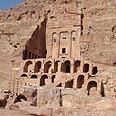
Petra's ancient stones still alive
City of stone made famous by 'Indiana Jones' alive today with tourists, barbers, hats and, oh yes, amazing sites
Petra served as capital of the Nabatean civilization.
Situated between the Red Sea and the Dead Sea, the Nabateans amassed considerable wealth during the first century BCE by taxing and plundering caravans on the important crossroads between Arabia, Egypt andSyria-Phoenicia.
The city features impressive temples, tombs, theaters and other buildings.
Built into mountains, Petra presents striking facades, impressing on visitors the immensity and intricacy of the work that went into carving out such buildings and halls.
A yawning chasm paves the entrance to Petra. As visitors walk through they are met by the imposing Great Temple, the best preserved and most remarkable façade in Petra.
The architecture is a blend of influences, reflecting the area’s pivotal location as the meeting of travellers from many countries and civilisations.
The Great Temple is the first building to meet visitors, coming at the end of a walk through a deep gorge. Visiting the site deserves at least a day, and the hikes up to the Monastery and High Sacrifice are rewarding, though tiring.
Overall Petra may leave visitors wondering why such effort and expense was poured into a city that is magnificently impractical.
Among the burqas
Getting to Petra on the cheap takes the better part of a day: It involves a bus down to Eilat among throngs of scantily clad 14-year-old Israelis. From Eilat the border is an NIS 20 (USD 4.50) taxi ride away, and then a three dinar (USD 4.50) taxi ride to Aqaba.
The bus from Aqaba up to Petra is a further three dinar each. The bus ride is a fun way of experiencing Jordan. You are among dozens of kefiya- and burqa-clad Jordanians, and the bus picks up passengers along the way until the vehicle can no longer climb the hills.
Jordanians are hospitable and are comfortable with Israeli and Jewish travelers. Jordan does not have the
same volume of tourism that you see in Israel, and there are at least as many Jordanians on the site
peddling their wares as tourists.
'Irish' pub
Despite having a bizarre amount of barbers, the town in Petra has few bars or things to do at night. The
Jordanian owners of the Cleopatra Hotel went out of their way to entertain us, either with nargileh (water
pipes) and tea, the ubiquitous Indiana Jones, or by taking us out to one of Petra’s only two bars - an
uninteresting “Irish pub” attached to a hotel.
Petra is entirely oriented to hosting visitors from elsewhere. As a result there are virtually no places
where you will be charged the same as locals, and haggling is neccesary before every purchase.
Israelis are used to driving a hard bargain, but it is amusing to watch people from elsewhere proving
themselves entirely incapable of haggling: The hotel owner swore to me the Japanese person in the next room was paying three times the rate, and I believed him.
Tip for better prices: Use whatever words of Arabic you have; it will improve your price.
Details:
- Exit pass from Israel - NIS 70 (USD 15.50)
- Typical accommodations (double room, including pick up from Petra, breakfast) - 15 Jordanian dinar (USD22.50)
- Entrance to Petra antiquity site - 10.5-21 Jordanian dinar (USD 16-32)
- Official tour guide - 15 dina (USD 22.50)
- Exit pass from Jordan - 5 dinar (USD 7.50)










